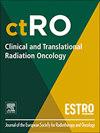使用诊断性CT扫描的无模拟姑息性放疗-是更少吗?系统回顾
IF 2.7
3区 医学
Q3 ONCOLOGY
引用次数: 0
摘要
全球癌症发病率持续上升,近一半的患者需要放疗。使用诊断性CT扫描代替专用计划CT的无模拟放射治疗(SFRT)是一种简化的替代方案,可以减少患者就诊次数,缩短治疗时间,而不会影响护理质量。本系统综述评估了SFRT在姑息性放疗中的实用性、剂量学准确性和临床结果。方法按照PRISMA指南,使用多个检索词检索PubMed和Embase中关于SFRT的出版物。纳入了报告临床或后勤终点的研究,如治疗时间、毒性、剂量学误差和患者报告的结果。结果11项研究符合纳入标准,包括回顾性和前瞻性队列,患者人数从10到1000不等。与传统工作流程相比,SFRT显著缩短了从咨询到治疗开始的时间间隔。使用诊断性CT扫描的剂量学不确定性通常较低,在胸部病例中观察到较高的变异性。患者选择通常排除了涉及陡剂量梯度、再照射或需要固定装置的治疗。有限的临床结果数据显示良好的毒性特征和有效的症状缓解。结论ssfrt为姑息性放疗提供了实用、高效的替代方案,在不影响特定患者安全性和有效性的情况下,可以更快地启动治疗并优化资源利用。总体剂量测定的准确性在大多数情况下是可以接受的,但对于胸部病变和复杂的治疗方案建议谨慎。需要更多具有可靠临床终点的前瞻性研究来进一步验证SFRT在姑息性放疗中的作用。本文章由计算机程序翻译,如有差异,请以英文原文为准。
Simulation-free palliative radiotherapy using diagnostic CT scans– is less more? A systematic review
Background
Cancer incidence continues to rise globally, with nearly half of patients requiring radiotherapy. Simulation-free radiotherapy (SFRT) using diagnostic CT scans instead of dedicated planning CTs is a streamlined alternative that may reduce patient visits and shorten time to treatment without impacting quality of care. This systematic review evaluates the practical aspects, dosimetric accuracy, and clinical outcomes of SFRT in palliative radiotherapy.
Methods
Following PRISMA guidelines, PubMed and Embase were searched for publications on SFRT using multiple search terms. Included studies reported clinical or logistical endpoints such as treatment timing, toxicity, dosimetric errors, and patient-reported outcomes.
Results
Eleven studies met inclusion criteria, comprising retrospective and prospective cohorts with patient numbers ranging from 10 to 1000. SFRT was associated with significantly reduced intervals from consultation to treatment start compared to conventional workflows. Dosimetric uncertainties using diagnostic CT scans were generally low, with higher variability observed in thoracic cases. Patient selection typically excluded treatments involving steep dose gradients, reirradiation, or requiring immobilization devices. Limited clinical outcome data showed favourable toxicity profiles and effective symptom relief.
Conclusions
SFRT offers a practical, efficient alternative for palliative radiotherapy, enabling faster treatment initiation and optimized resource use without compromising safety or efficacy in selected patients. The overall dosimetric accuracy appears acceptable for most cases, though caution is advised for thoracic lesions and complex treatment plans. Additional prospective studies with robust clinical endpoints are needed to further validate the role of SFRT in palliative radiotherapy.
求助全文
通过发布文献求助,成功后即可免费获取论文全文。
去求助
来源期刊

Clinical and Translational Radiation Oncology
Medicine-Radiology, Nuclear Medicine and Imaging
CiteScore
5.30
自引率
3.20%
发文量
114
审稿时长
40 days
 求助内容:
求助内容: 应助结果提醒方式:
应助结果提醒方式:


